Floristic and Anatomical Diversity of Crataegus ambigua C.A.Mey. ex A.K.Becker Populations in Different Areas of the Arid Mangystau Region (Kazakhstan)
Abstract
1. Introduction
2. Materials and Methods
2.1. Study Area and Climate
2.2. Plant Materials
2.3. Floristic, Ecological, and Anatomical Methods of Analysis
2.4. Statistical Analyses
3. Results
3.1. Floristic and Ecological Analysis
3.2. Analysis of Population Biological Diversity
3.3. Anatomical Study of a Leaf and an Annual Shoot of C. ambigua
3.4. Statistical Data Processing
4. Discussion
5. Conclusions
Author Contributions
Funding
Data Availability Statement
Conflicts of Interest
References
- Duguma, H.T. Wild edible plant nutritional contribution and consumer perception in Ethiopia. Int. J. Food Sci. 2020, 2020, 2958623. [Google Scholar] [CrossRef] [PubMed]
- Garcia-Oliveira, P.; Fraga-Corral, M.; Pereira, A.G.; Lourenco-Lopez, C.; Jimenez-Lopez, C.; Prieto, M.A.; Simal-Gandara, J. Scientific basis for the industrialization of traditionally used plants of the Rosaceae family. Food Chem. 2020, 330, 1043127197. [Google Scholar]
- Mixitdinov, S.M.; Hasanov, Z.D.; Maydanov, M.J.; Neymanov, F.F. Medical significance of Rosaceae representatives. Sci. Innov. 2022, 1, 179–184. [Google Scholar] [CrossRef]
- Kang, C.; Yao, J.-L.; Liu, Z.; Han, Y. Editorial: Rosaceae fruit development and quality. Front. Plant Sci. 2022, 12, 837300. [Google Scholar] [CrossRef]
- Li, M.; Xiao, Y.; Mount, S.; Liu, Z. An atlas of genomic resources for studying Rosaceae fruits and ornamentals. Front. Plant Sci. 2021, 12, 644881. [Google Scholar] [CrossRef]
- Sores, S.S.; Bekbolatova, E.; Cotrin, M.D.; Sakipova, Z.; Ibragimova, L.; Kukula-Koch, W.; Sardell Giorno, T.h.B.; Fernandes, P.D.; Fonseca, D.A.; Bpylan, F. Chemistry and pharmacolofy of the Kazakh Crataegus almaatensis Pojark: An Asian herbal medicine. Antioxidants 2019, 8, 300. [Google Scholar] [CrossRef]
- Kumar, D.; Arya, V.; Ali Bhat, Z.; Ahmad Khan, N.; Prasad, D.N. The genus Crataegus: Chemical and pharmacological perspectives. Rev. Brasil. Farmacogn. 2012, 22, 1187–1200. [Google Scholar]
- Han, J.; Tan, D.; Liu, G. Hawthorn—A health food. Appl. Mech. Mater. 2012, 140, 350–354. [Google Scholar]
- Antonio, B.T.J.; Margarita, C.R.; Daniel, M.I. Biological Properties and Antioxidant Activity of Hawthorn Crataegus mexicana. J. Pharmacogenomics Pharmacoproteomics 2015, 6, 153. [Google Scholar] [CrossRef]
- Sagaradze, V.A.; Babaeva, E.Y. Resources and use of Crataegus species (Rosaceae) of the Asian part of Russia. Plant Resour. 2022, 58, 5–19. [Google Scholar]
- Gundogdu, M.; Ozrenk, K.; Ercisli, S.; Kan, T.; Kodad, O.; Hegedus, A. Organic acids, sugars, vitamin C content and some pomological characteristics of eleven hawthorn species (Crataegus ssp.) from Turkey. Biol. Res. 2014, 47, 21. [Google Scholar] [CrossRef] [PubMed]
- Edwards, J.E.; Brown, P.; Talent, N.; Dickinson, T.A.; Shipley, P.R. A review of the chemistry of the genus Crataegus. Phytochemistry 2012, 79, 5–26. [Google Scholar] [CrossRef] [PubMed]
- Flora of Kazakhstan; Science: Almaty, Kazakhstan, 1961; Volume 4, pp. 406–411.
- Baytenov, M.S. Flora of Kazakhstan; Family Composition of the Flora; Gylym: Almaty, Kazakhstan, 2001; Volume 2, p. 113. [Google Scholar]
- Abdulina, S.A. Spisok Sosudistykn Rastenii Kazakhstana: 1–187; Academy of Sciences: Almaty, Kazakhstan, 1999. [Google Scholar]
- Aralbay, N.K.; Kudabaeva, G.M.; Imanbaeva, A.A.; Veselova, P.V.; Danilov, M.P.; Kurmantaeva, A.A.; Shadrina, N.V.; Kasenova, B.T. State Cadastre of Plants of the Mangistau Region. Synopsis of Higher Vascular Plants; Printing House LLP “Classics”: Aktau, Kazakhstan, 2006; 229p. (In Russian) [Google Scholar]
- Safronova, I.N. Vegetation of Mangyshlak Deserts. Proc. Bot. Inst. RAS 1996, 18, 211. [Google Scholar]
- Kew Royal Botanic Gardens. Plants of the World Online (POWO). Crataegus ambigua C.A. Mey. ex A.K. Becker. Available online: https://powo.science.kew.org/results?q=Crataegus%20ambigua (accessed on 30 December 2024).
- Global Biodiversity Information Facility (GBIF). Crataegus ambigua. Available online: https://www.gbif.org/search?q=Crataegus%20ambigua (accessed on 30 December 2024).
- World Flora Online (WFO). Crataegus ambigua C.A. Mey. Available online: https://wfoplantlist.org/taxon/wfo-0001011563-2024-12?page=1 (accessed on 30 December 2024).
- Oregon State University, College of Agricultural Sciences, Department of Horticulture. Landscape Plants. Available online: https://landscapeplants.oregonstate.edu/plants/crataegus-ambigua (accessed on 30 December 2024).
- Plant Select. Available online: https://plantselect.org/plant/crataegus-ambigua/ (accessed on 30 December 2024).
- Convention on Biological Biodiversity; 1992. Available online: https://www.cbd.int/convention (accessed on 30 December 2024).
- Red Book of Kazakhstan; Plants. Available online: https://ile-balkhash.kz/en/red-list (accessed on 30 December 2024).
- Aralbay, N.K.; Kudabaeva, G.M.; Imanbayeva, A.A. Catalog of Rare and Endangered Plant Species of the Mangystau Region; Science: Aktau, Kazakhstan, 2006; 32p. [Google Scholar]
- International Union for Conservation of Nature. The IUCN Red List of Threatened Species. Available online: https://www.iucnredlist.org/species/63506/12683423 (accessed on 30 December 2024).
- Imanbayeva, A.; Duisenova, N.; Orazov, A.; Sagyndykova, M.; Belozerov, I.; Tuyakova, A. Study of the Floristic, Morphological, and Genetic (atpF–atpH, Internal Transcribed Spacer (ITS), matK, psbK–psbI, rbcL, and trnH–psbA) Differences in Crataegus ambigua Populations in Mangystau (Kazakhstan). Plants 2024, 13, 1591. [Google Scholar]
- Dikareva, T.V. Ecological and cenotic analysis of plant species in the Red Book of Kazakhstan. Ecosyst. Ecol. Dyn. 2017, 1, 132–145. [Google Scholar]
- Imanbayeva, A.A.; Duisenova, N.I.; Ishmuratova, M.Y.; Kopbaeva, G.B. Phytocenotic characteristics of communities with Crataegus ambigua in the Akmysh and Botakan gorges (Western Kazakhstan). Bull. KazNU Biol. Ser. 2017, 3, 6–13. [Google Scholar]
- Duysenova, N.I.; Imanbaeva, A.A.; Ishmuratova, M.Y. The study of the state and structure of populations of rare plant of Mangyshlak Crataegus ambigua C.A. Mey ex A. Beck. Ecol. Environ. Conserv. 2016, 22, 523–529. [Google Scholar]
- Tuyakova, A.T.; Imanbaeva, A.A.; Duysenova, N.I.; Ishmuratova, M.Y. Anatomical structure study of aerial organs of Crataegus ambigua C.A. Mey. Biosci. Biotechnol. Res. Asia 2016, 13, 1303–1309. [Google Scholar]
- Tuyakova, A.T.; Imanbayeva, A.A.; Ishmuratova, M.Y.; Zhumakhan, D.M.; Orazova, S.B. Anatomical features of aboveground organs of Crataegus ambigua C.A. Mey in the Western Karatau gorges. Bull. KazNU Biol. Ser. 2016, 2, 25–31. [Google Scholar]
- Tyulkova, E.G. Anatomical structure features of tree leaves as an indicator of adaptation to growing conditions. Izv. Gomel State Univ. 2019, 3, 63–69. [Google Scholar]
- Tyukavina, O.N.; Neverov, N.A.; Klevtsov, D.N. Influence of growing comditionds on morphological and anatomical characteristics of pine needles in the northern taiga. J. For. Sci. 2019, 65, 33–39. [Google Scholar] [CrossRef]
- Terleyskaya, N.; Kurmanbayeva, M. Change in leaf anatomical parameters of seedlings of different wheat species under conditions of drought and salt stress. Pak. J. Bot. 2017, 49, 857–865. [Google Scholar]
- Childibayeva, A.; Ametov, A.; Kurbatova, N.V.; Akhmetova, A.; Tynybekov, B.M.; Mukanova, G.A. Structural characteristics of Rosa iliensis Chrshan. Under conditions of the floodplains of the river Ili and Sharyn. J. Ecol. Eng. 2022, 23, 296–304. [Google Scholar] [CrossRef]
- Barykina, R.P.; Veselova, T.D.; Devyatov, A.G.; Jalilova, K.K.; Ilyina, G.M.; Chubatova, N.V. Handbook of Botanical Microtechnique: Basics and Methods; Moscow State University: Moscow, Russia, 2004; 322p. [Google Scholar]
- Koshim, A.G.; Sergeyeva, A.M.; Bexeitova, R.T.; Aktymbayeva, A.S. Landscape of the Mangystau region in Kazakhstan as a geomorphotourism destination: A geographical review. Geo J. Tour. Geosites 2020, 29, 385–397. [Google Scholar]
- Sukachev, V.N.; Zonn, S.V.; Motovilov, G.P. Methodical Instructions for Studying Forest Types; Publishing House of the USSR Academy of Sciences: Moscow, Russia, 1957. [Google Scholar]
- Sukachev, V.N. Forest Biogeocenology as a Theoretical Basis for Forestry and Forest Management; Issues of Forest Science and Forestry; Publishing House of the USSR Academy of Sciences: Moscow, Russia, 1960. [Google Scholar]
- Pott, R. Phytosociology: A modern geobotanical method. Plant Biosyst. Int. J. Deal. All Asp. Plant Biol. 2011, 145 (Suppl. S1), 9–18. [Google Scholar]
- Kafle, G. Diagnostic Horizons of Soils in the World; Academia Letters: San Francisco, CA, USA, 2022. [Google Scholar]
- POWO. Plants of the World Online. Facilitated by the Royal Botanic Gardens, Kew. 2024. Available online: http://www.plantsoftheworldonline.org (accessed on 1 September 2024).
- Muradov, S.V.; Devyatova, E.A.; Golovina, T.P. Laboratory Practicum on Microtechnique; Publishing House “Sreda”: Cheboksary, Russia, 2019; 84p. [Google Scholar]
- Vinogradova, G.N.; Zakharov, V.V. Basics of Microscopy. Part 1; ITMO: St. Petersburg, Russia, 2018; 135p. [Google Scholar]
- Evert, R.F. Plant Anatomy by Esau: Meristems, Cells, and Tissues of the Plant Body: Structure, Functions, and Development; BINOM: Moscow, Russia, 2015; 600p. [Google Scholar]
- Crang, R.; Lyons-Sobaski, S.; Wise, R. Plant Anatomy. A Concept-Based Approach to the Structure of Sed Plants; Textbook; Springer: Berlin/Heidelberg, Germany, 2018. [Google Scholar] [CrossRef]
- Aidosova, S.S.; Akhtaeva, N.Z.; Tuleuova, G.K.H.; Ahmetova, A.B.; Tazhibay, A.M.; Shaushekov, Z.K.; Shurupova, M.N.; Adekenov, S.M. Compara tive morphological and anatomical characteristics of Saussurea amara (L.) DC. and S. salsa Pall. Spreng. Pak. J. Bot. 2018, 51, 213–219. [Google Scholar]
- Lotova, L.I. Morphology and Anatomy of Higher Plants; Editorial URSS: Moscow, Russia, 2001; 528p. [Google Scholar]
- Volkova, N.A.; Kurkin, V.A.; Pravdivtseva, O.E.; Andreev, A.A.; Kurkina, A.V.; Pervushkin, S.V.; Agapov, A.I. Morphological and anatomical study of Crataegus submollis Sarg. Shoots. Aspir. Vestn. Povolzhiya 2023, 23, 31–35. [Google Scholar] [CrossRef]
- Aslam, M.; Ullah, M.I. Practicing R for Statistical Computing; Springer: Berlin/Heidelberg, Germany, 2023. [Google Scholar]
- Zar, J.H. Biostatistical Analysis; Pearson Education India: Upper Saddle River, NJ, USA, 1999. [Google Scholar]
- Koblanova, S.; Mukhtubayeva, S.; Kakimzhanova, A.; Orazov, A.; Dyussembekova, D.; Abileva, G. Diversity of birch and alder forests in the Kostanay region of Kazakhstan. Forests 2024, 15, 1680. [Google Scholar] [CrossRef]
- Sokal, R.R.; Rohlf, F.J. Biometry: The Principles and Practice of Statistics in Biological Research, 3rd ed.; W.H. Freeman and Company: New York, NY, USA, 1995; pp. 451–554. [Google Scholar]
- Tukey, J.W. Exploratory Data Analysis; Addison-Wesley: Reading, MA, USA, 1977. [Google Scholar]
- Pearson, K. On Lines and Planes of Closest Fit to Systems of Points in Space. Philos. Mag. 1901, 2, 559–572. [Google Scholar]
- Jolliffe, I.T.; Cadima, J. Principal component analysis: A review and recent developments. Philos. Trans. R. Soc. A Math. Phys. Eng. Sci. 2016, 374, 20150202. [Google Scholar]
- Ter Braak, C.J.F.; Smilauer, P. CANOCO Reference Manual and User’s Guide to Canoco for Windows: Software for Canonical Community Ordination, Version 4.5; Microcomputer Power: Ithaca, NY, USA, 2002. [Google Scholar]
- Evert, R.F. Esau’s Plant Anatomy Consists of the Meristems, Cells, and Tissues of the Plant Body, as Well as Their Structure, Function, and Development; John Wiley & Sons: Hoboken, NJ, USA, 2006. [Google Scholar]
- Fahn, A. Plant Anatomy; Pergamon Press: Oxford, UK, 1990. [Google Scholar]
- Kherraze, M.E.; Belhamra, M.; Grigore, M.N. Aspects of ecological anatomy of Traganum nudatum Del. (Amaranthaceae) from the Northeast of the Algerian Sahara. Acta Biol. Szeged. 2018, 62, 25–36. [Google Scholar]
- Esau, K.; Cheadle, V.I. Anatomy of the secondary phloem in Winteraceae. IAWA J. 1984, 5, 13–43. [Google Scholar]
- Eidelberg, D.; Moeller, J.R.; Dhawan, V.; Sidtis, J.J.; Ginos, J.Z.; Strother, S.C.; Cedarbaum, J.; Greene, P.; Fahn, S.; Rottenberg, D.A. The metabolic anatomy of Parkinson’s disease: Complementary [18F] fluorodeoxyglucose and [18F] fluorodopa positron emission tomographic studies. Mov. Disord. Off. J. Mov. Disord. Soc. 1990, 5, 203–213. [Google Scholar]
- Izquierdo, J.V.; Canaveze, Y.; Machado, S.R.; Amorim, F.W. Anatomical, histochemical, and developmental approaches reveal the long-term functioning of the floral nectary in Tocoyena formosa (Rubiaceae). Sci. Nat. 2024, 111, 25. [Google Scholar]
- Cloudsley-Thompson, J.L. Biotic Interactions in Arid Lands; Springer Science & Business Media: Berlin/Heidelberg, Germany, 2012. [Google Scholar]
- Wang, W.; Wang, Y.; Hoch, G.; Wang, Z.; Gu, J. Linkage of root morphology to anatomy with increasing nitrogen availability in six temperate tree species. Plant Soil 2018, 425, 189–200. [Google Scholar]
- Barlow, C.J. Changes in Aquatic Plant Community Structure and Species Distribution at Caddo Lake; Stephen, F., Ed.; Austin State University: Nacogdoches, TX, USA, 2006. [Google Scholar]
- Mengistie, E.; McDonald, A.G. Effect of cell wall compositions on lodging resistance of cereal crops. J. Agric. Sci. 2023, 161, 794–807. [Google Scholar]
- Martínez-Vilalta, J.; Lloret, F. Drought-induced vegetation shifts in terrestrial ecosystems: The key role of regeneration dynamics. Glob. Planet. Change 2016, 144, 94–108. [Google Scholar]
- Venturas, M.D.; Sperry, J.S.; Hacke, U.G. Plant xylem hydraulics: What we understand, current research, and future challenges. J. Integr. Plant Biol. 2017, 59, 356–389. [Google Scholar]
- Wilkening, J.V.; Skelton, R.P.; Feng, X.; Dawson, T.E.; Thompson, S.E. Exploring within-plant hydraulic trait variation: A test of the vulnerability segmentation hypothesis. Plant Cell Environ. 2023, 46, 2726–2746. [Google Scholar]
- Flexas, J.; Clemente-Moreno, M.J.; Bota, J.; Brodribb, T.J.; Gago, J.; Mizokami, Y.; Nadal, M.; Perera-Castro, A.V.; Roig-Oliver, M.; Sugiura, D.; et al. Cell wall thickness and composition are involved in photosynthetic limitation. J. Exp. Bot. 2021, 72, 3971–3986. [Google Scholar]
- Salmurzauly, R.; Myrzagaliyeva, A.; Irsaliyev, S.; Samarkhanov, T.; Orazov, A.; Nurtazin, S.; Altynbek, M.; Sagynysh, B. Fraxinus sogdiana Bunge forests in Charyn Canyon, Kazakhstan. Casp. J. Environ. Sci. 2024, 22, 1117–1131. [Google Scholar]
- Battaglia, M.; Oliviero, M. LEA proteins and the mechanisms of water stress tolerance in plants. Plant Cell Environ. 2008, 31, 163–174. [Google Scholar] [CrossRef]
- Munné-Bosch, S.; Alegre, L. Antioxidant content and oxidative stress in plants. In Antioxidants in Higher Plants; Springer: Berlin/Heidelberg, Germany, 2004; pp. 175–206. [Google Scholar]
- Akzhunis, I.; Dinara, Z.; Nurzhaugan, D.; Aidyn, O.; Nazerke, T.; Gulmira, T. Unravelling the Chloroplast Genome of the Kazakh Apricot (Prunus armeniaca L.) Through MinION Long-Read Sequencing. Plants 2025, 14, 638. [Google Scholar] [CrossRef] [PubMed]

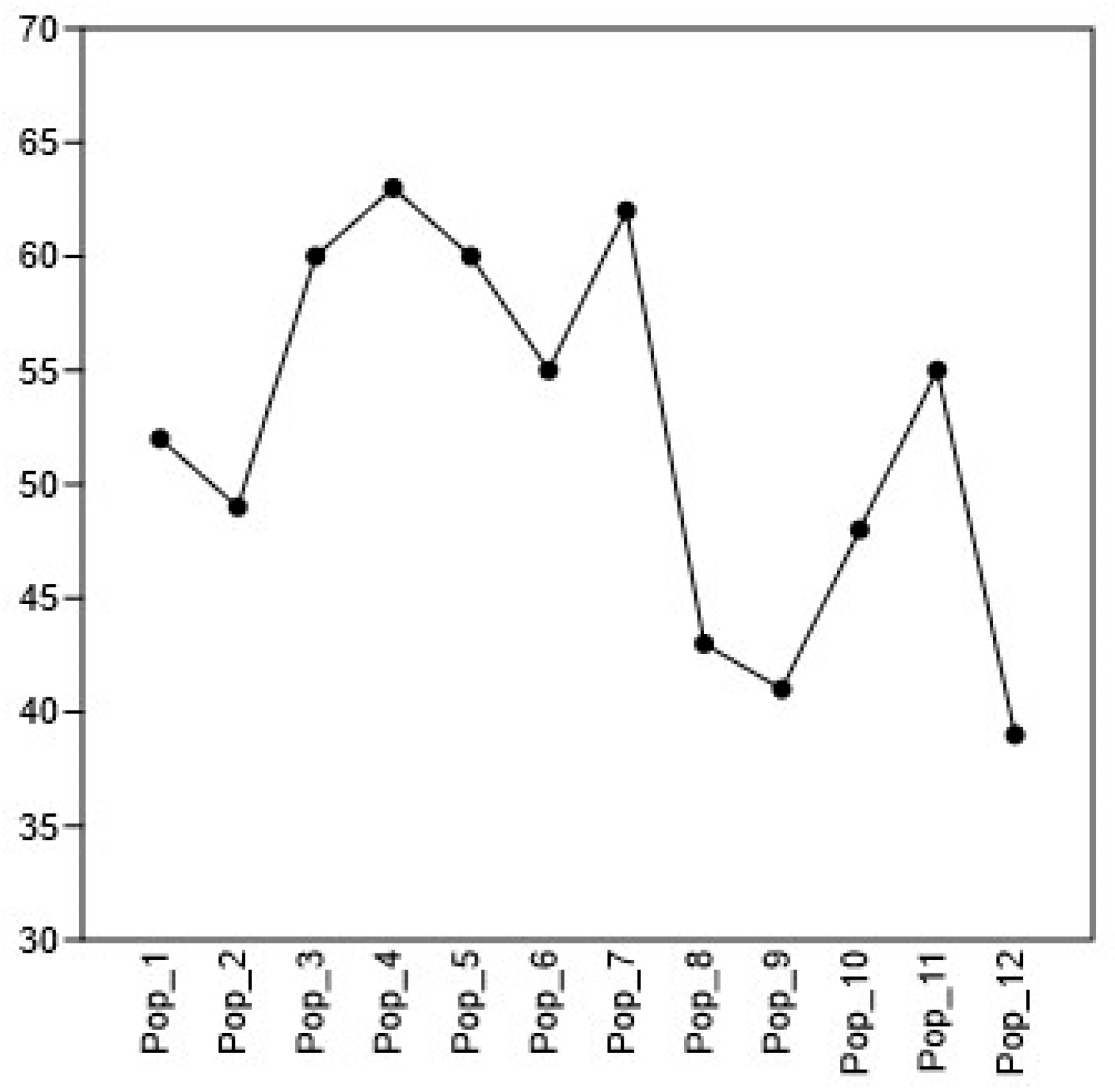
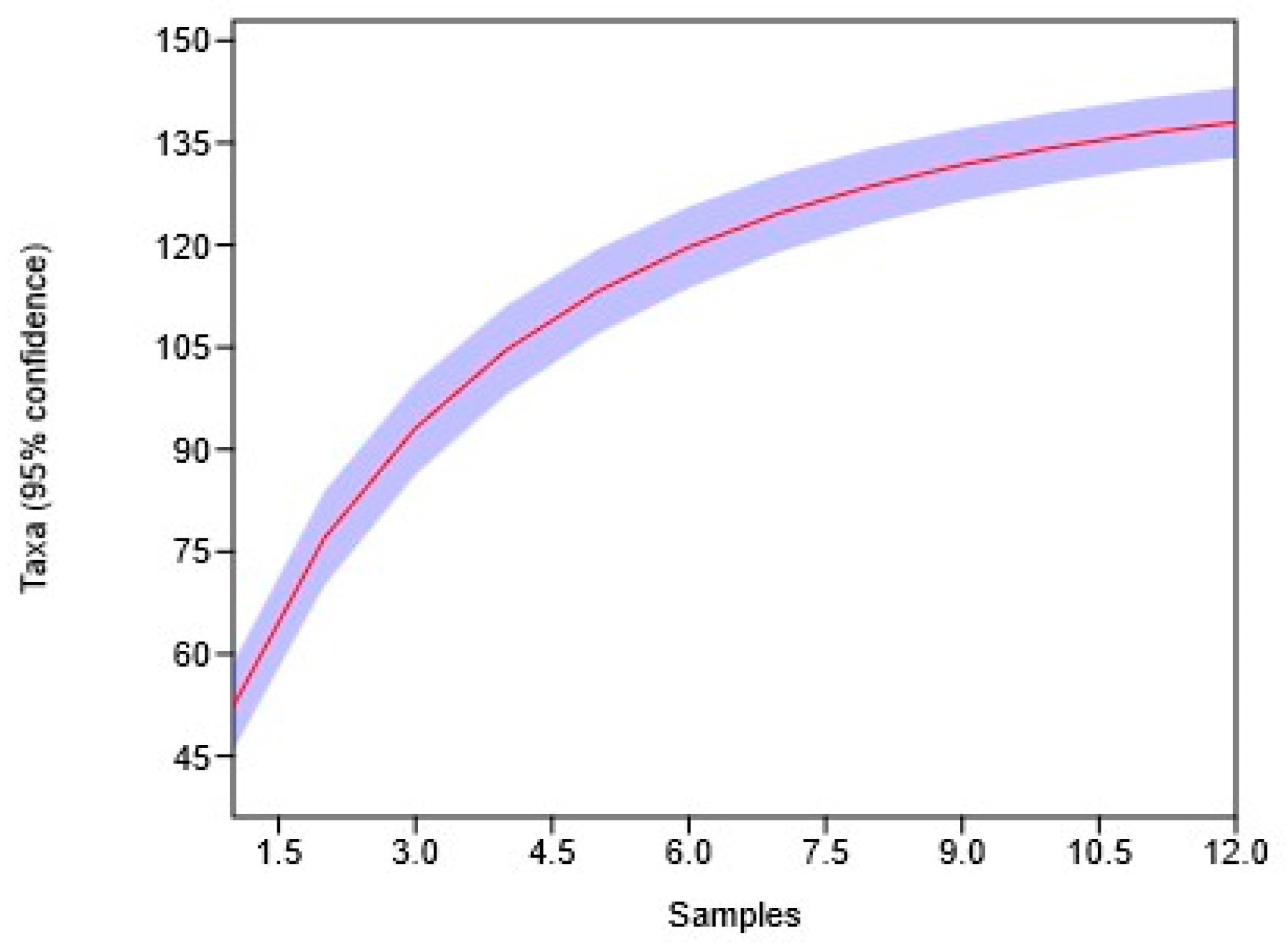
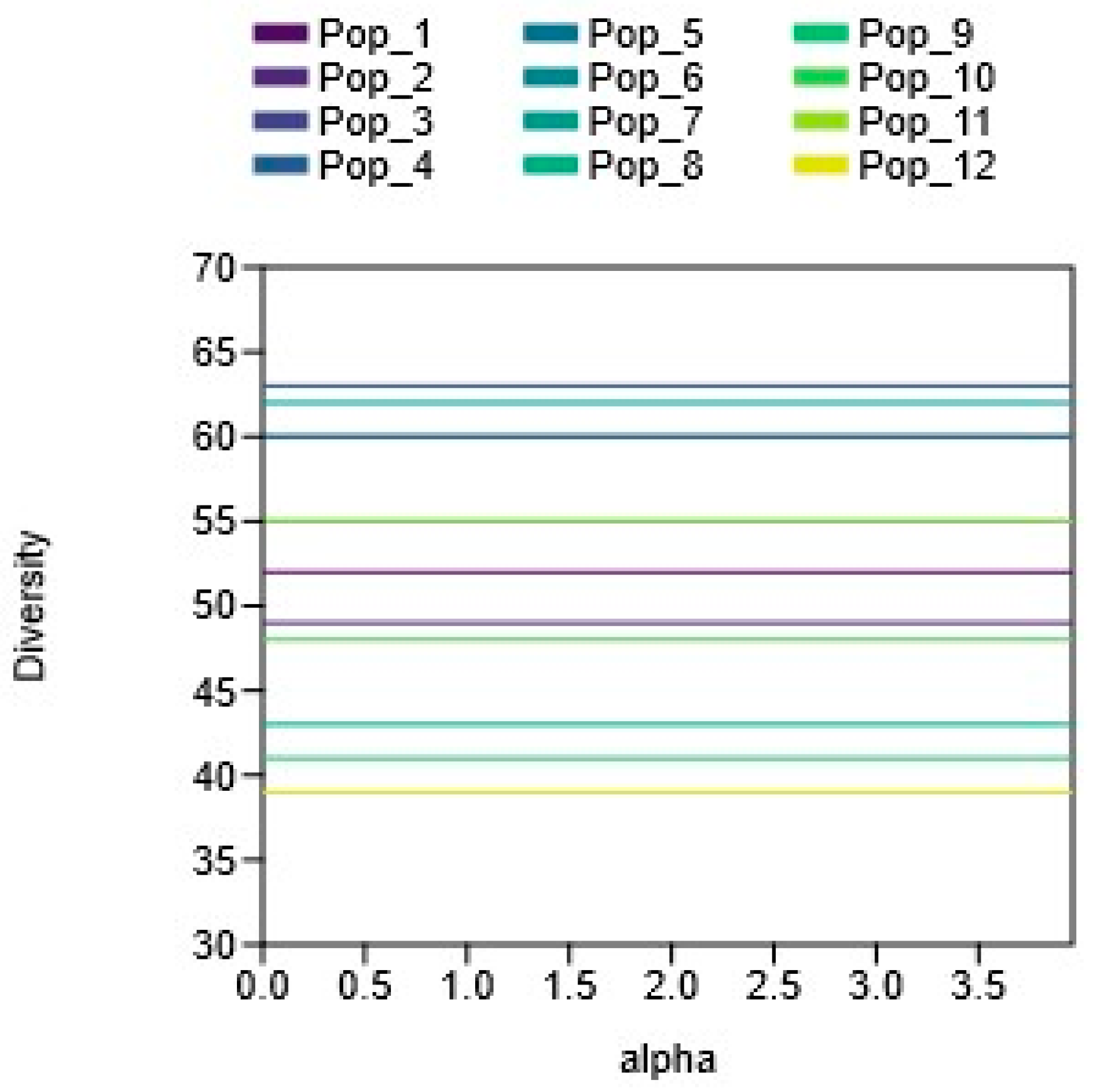

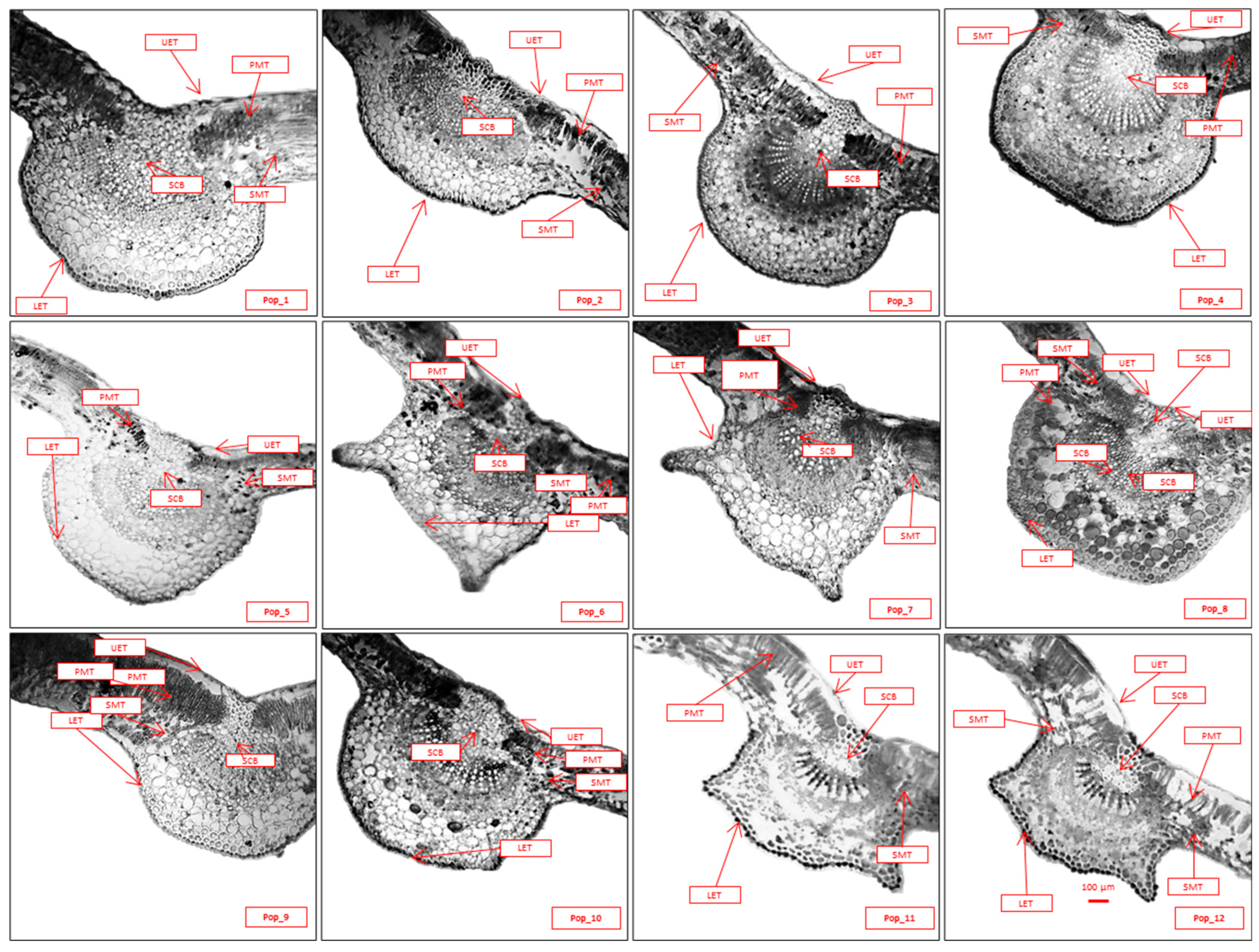
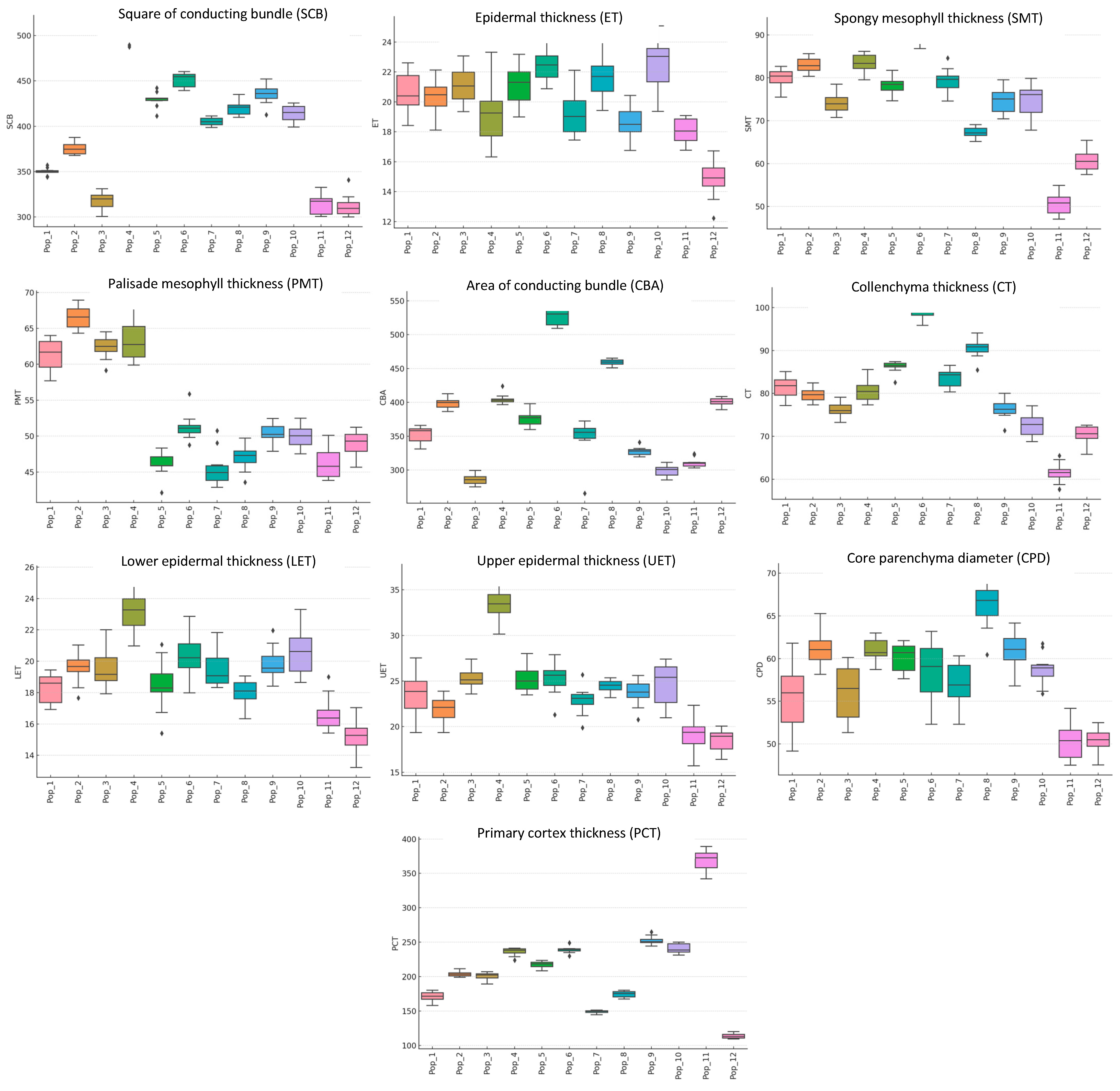
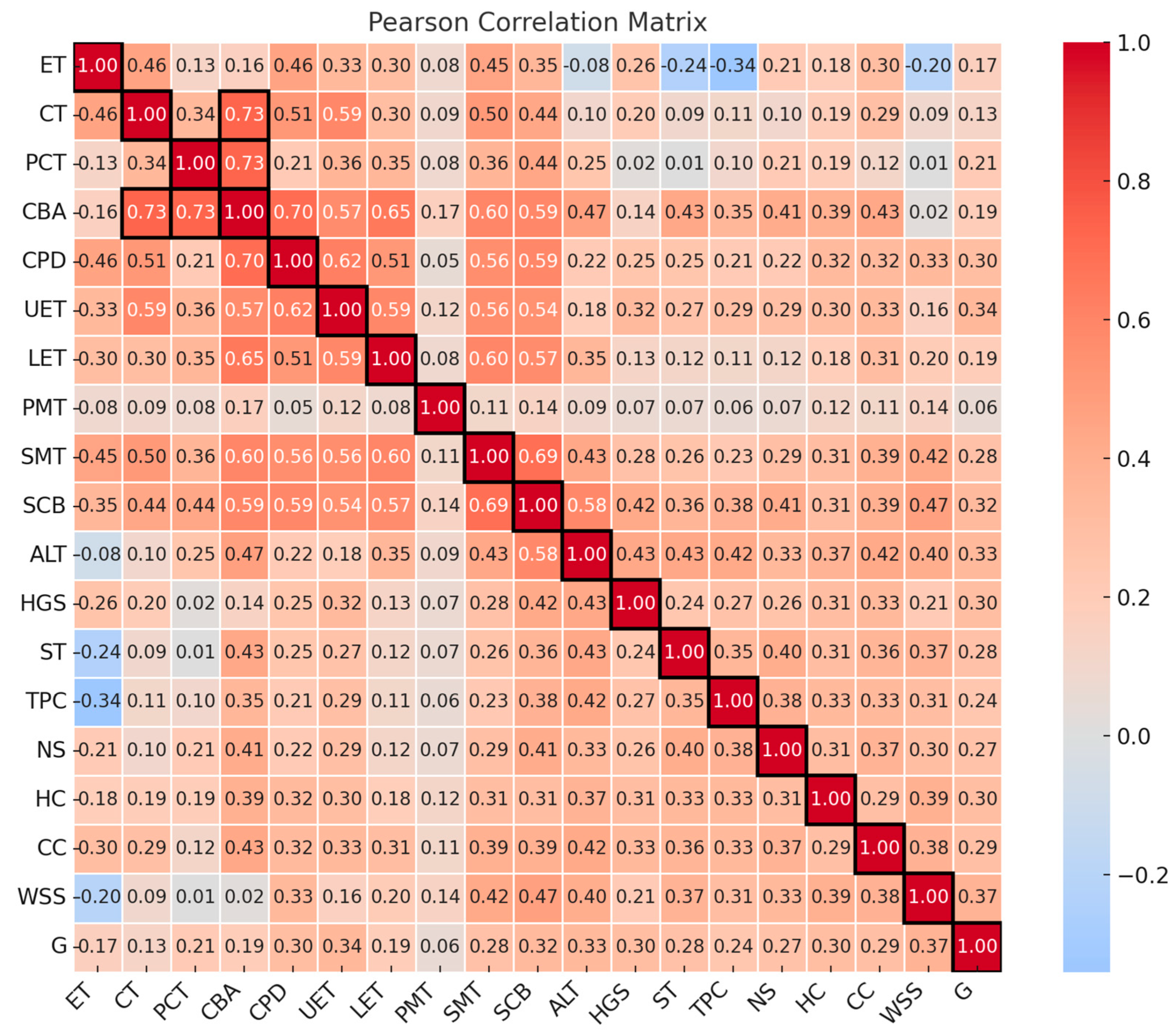
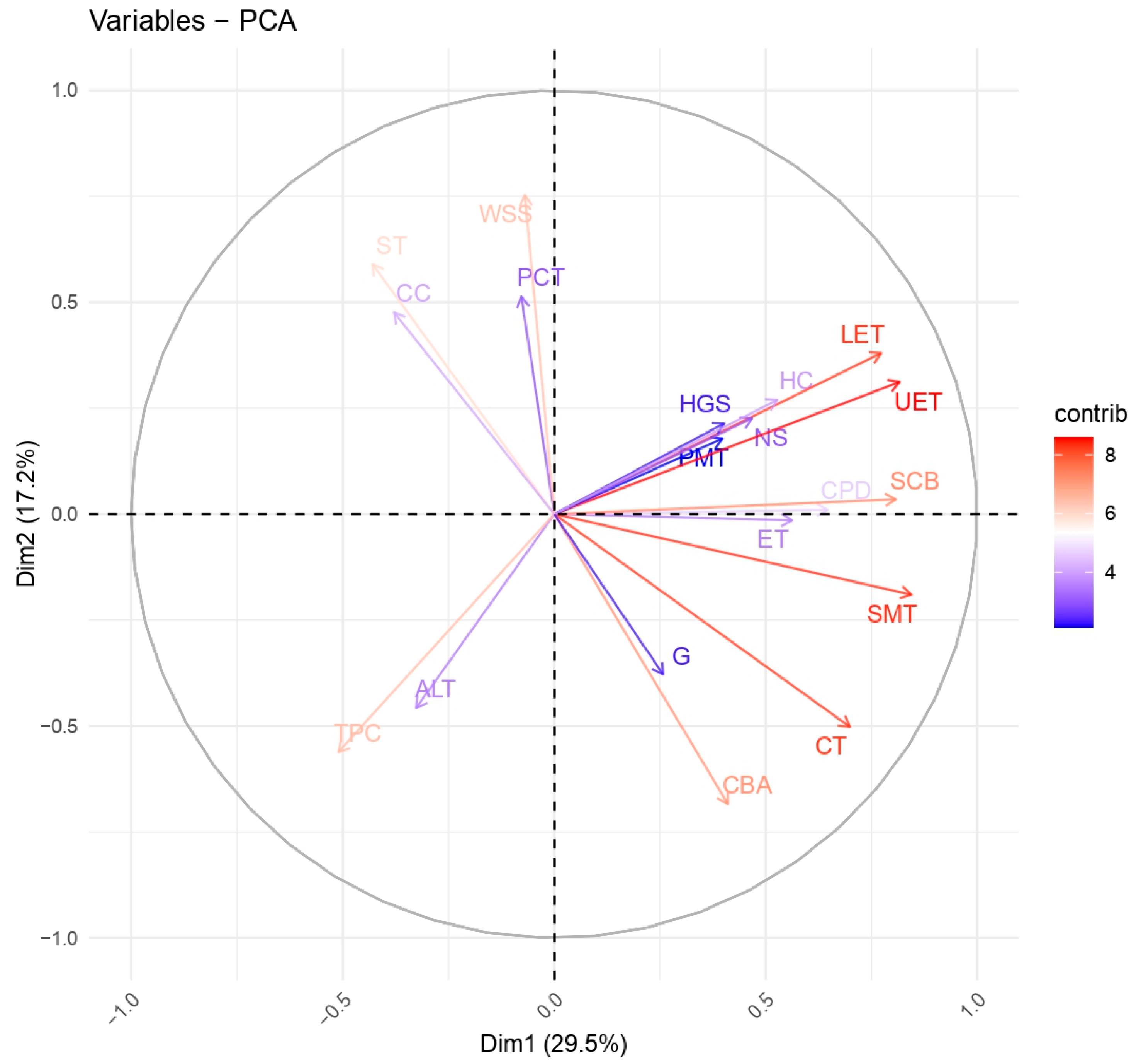

| Pop | GPS | Altitude (m) | Geographical Location | Height of the Gorge Slopes (m) | Ecological Conditions | Number of Species (pcs.) | Total Projective Coverage (%) | Soil Type | Humus Content (%) | Carbonate Content (%) | Amount of Water-Soluble Salts (%) | Grazing |
|---|---|---|---|---|---|---|---|---|---|---|---|---|
| Pop_1 | 44°12′48.9″ N, 51°41′11.1″ E | 184 | Western Karatau | 25 | Semi-arid, temporary watercourses | 51 | 61 | Brown, clayey | 0.43 | 8.3 | 0.15 | Yes |
| Pop_2 | 44°08′16.2″ N, 50°54′58.2″ E | 196 | Western Karatau | 200 | Arid, rocky outcrops | 48 | 52 | Brown, clayey | 0.31 | 7.7 | 0.17 | Yes |
| Pop_3 | 44°28′015″ N, 51°25′251″ E | 215 | Western Karatau | 350 | Semi-arid, permanent watercourses | 60 | 40 | Calcareous, loamy | 0.45 | 9.8 | 0.33 | No |
| Pop_4 | 42°57′47.8″ N, 54°41′56.6″ E | 141 | Peninsula Tubkaragan | 170 | Arid, rocky soils | 65 | 30 | Brown, loamy | 0.74 | 6.1 | 0.18 | No |
| Pop_5 | 44°12′48.9″ N, 51°41′11.1″ E | 275 | Western Karatau | 250 | Moderately arid, permanent watercourses | 58 | 65 | Brown, sandy loam | 0.52 | 6.4 | 0.21 | Yes |
| Pop_6 | 44°12′56.8″ N, 51°59′37.0″ E | 247 | Western Karatau | 230 | Semi-arid, proximity to water sources | 55 | 50 | Brown, loamy | 0.39 | 7.3 | 0.12 | Yes |
| Pop_7 | 44°17′13.4″ N, 51°40′01.4″ E | 253 | Western Karatau | 120 | Arid, rare watercourses | 63 | 54 | Brown, loamy | 0.56 | 8.6 | 0.23 | Yes |
| Pop_8 | 44°28′18.4″ N, 51°00.417″ E | 172 | Peninsula Tubkaragan | 50 | Moderately arid, proximity to the sea | 43 | 36 | Brown, loamy | 0.23 | 7.5 | 0.17 | No |
| Pop_9 | 44°27′38.2″ N, 50°35′25.2″ E | 136 | Peninsula Tubkaragan | 150 | Arid, temporary streams | 41 | 47 | Limestone, loamy | 0.22 | 12.2 | 0.4 | Yes |
| Pop_10 | 44°27′38.2″ N, 50°35.252″ E | 170 | Peninsula Tubkaragan | 95 | Semi-arid, permanent watercourses | 48 | 35 | Brown, sandy | 0.35 | 8.1 | 0.21 | No |
| Pop_11 | 44°17′15.8″ N, 52°01′17,8″ E | 255 | Western Karatau | 45 | Arid, rocky outcrops | 56 | 55 | Brown, gravelly | 0.47 | 7.9 | 0.18 | No |
| Pop_12 | 44°13′8.40″ N, 51°54′48.8″ E | 234 | Western Karatau | 90 | Arid, temporary streams | 39 | 63 | Brown, loamy | 0.13 | 8.3 | 0.14 | No |
| Parameters | Pop_1 | Pop_2 | Pop_3 | Pop_4 | Pop_5 | Pop_6 | Pop_7 | Pop_8 | Pop_9 | Pop_10 | Pop_11 | Pop_12 |
| Taxa_S | 52 | 49 | 60 | 63 | 60 | 55 | 62 | 43 | 41 | 48 | 55 | 39 |
| Dominance_D | 0.01923 | 0.02041 | 0.01667 | 0.01587 | 0.01667 | 0.01818 | 0.01613 | 0.02326 | 0.02439 | 0.02083 | 0.01818 | 0.02564 |
| Simpson_1-D | 0.9808 | 0.9796 | 0.9833 | 0.9841 | 0.9833 | 0.9818 | 0.9839 | 0.9767 | 0.9756 | 0.9792 | 0.9818 | 0.9744 |
| ShannonH_log2 | 45843 | 5.615 | 5.907 | 5.977 | 5.907 | 5.781 | 5.954 | 5.426 | 5.358 | 5.585 | 5.781 | 5.285 |
| Evenness_e^H/S | 0.03845 | 0.0408 | 0.03332 | 0.03174 | 0.03332 | 0.03635 | 0.03225 | 0.04649 | 0.04875 | 0.04165 | 0.03635 | 0.05125 |
| Brillouin | 3.007 | 34731 | 3.144 | 3.191 | 3.144 | 45811 | 3.175 | 2.826 | 2.781 | 2.931 | 45811 | 2.734 |
| Menhinick | 7.211 | 7 | 7.746 | 7.937 | 7.746 | 7.416 | 7.874 | 6.557 | 6.403 | 6.928 | 7.416 | 6.245 |
| Margalef | 33573 | 12389 | 14.41 | 14.96 | 14.41 | 13.48 | 14.78 | 43040 | 28399 | 41974 | 13.48 | 13789 |
| Berger–Parker | 0.01923 | 0.02041 | 0.01667 | 0.01587 | 0.01667 | 0.01818 | 0.01613 | 0.02326 | 0.02439 | 0.02083 | 0.01818 | 0.02564 |
| Chao 1 | 1353 | 1201 | 1801 | 1985 | 1801 | 1513 | 1923 | 925 | 841 | 1153 | 1513 | 761 |
| Original data set: | Standard devs: | |
| Observed S: | 138 | |
| Chao 2: | 144.699 | 4.22035 |
| Jackknife 1: | 156.333 | 5.95352 |
| Jackknife 2: | 154.061 | NA |
| Bootstrap: | 148.689 | NA |
| Bootstrap replicate mean: | Standard devs: | |
| Chao 2: | 136.113 | 10.0046 |
| Jackknife 1: | 143.769 | 9.66027 |
| Jackknife 2: | 143.619 | 15.4888 |
| Bootstrap: | 130.741 | 7.29763 |
| Whittaker: | 1,647,611.00 |
| Harrison: | 0.1492 |
| Cody: | 257.5 |
| Routledge: | 0.31555 |
| Wilson–Shmida: | 2,696,313.00 |
| Mourelle: | 0.44802 |
| Harrison 2: | 0.10823 |
| Williams: | 0.54348 |
| Pop_1 | Pop_2 | Pop_3 | Pop_4 | Pop_5 | Pop_6 | Pop_7 | Pop_8 | Pop_9 | Pop_10 | Pop_11 | Pop_12 | |
| Pop_1 | 0 | 0.32673 | 0.42857 | 0.4087 | 0.48214 | 0.58879 | 0.61404 | 0.53684 | 0.56989 | 0.56 | 0.64486 | 0.62637 |
| Pop_2 | 0.32673 | 0 | 0.50459 | 0.39286 | 0.54128 | 0.61538 | 0.62162 | 0.54348 | 0.6 | 0.52577 | 0.65385 | 0.61364 |
| Pop_3 | 0.42857 | 0.50459 | 0 | 0.33333 | 0.45 | 0.44348 | 0.45902 | 0.39806 | 0.36634 | 0.40741 | 0.49565 | 0.45455 |
| Pop_4 | 0.4087 | 0.39286 | 0.33333 | 0 | 0.44715 | 0.55932 | 0.44 | 0.4717 | 0.5 | 0.47748 | 0.55932 | 0.47059 |
| Pop_5 | 0.48214 | 0.54128 | 0.45 | 0.44715 | 0 | 0.49565 | 0.44262 | 0.35922 | 0.46535 | 0.38889 | 0.47826 | 0.45455 |
| Pop_6 | 0.58879 | 0.61538 | 0.44348 | 0.55932 | 0.49565 | 0 | 0.52137 | 0.32653 | 0.39583 | 0.45631 | 0.30909 | 0.42553 |
| Pop_7 | 0.61404 | 0.62162 | 0.45902 | 0.44 | 0.44262 | 0.52137 | 0 | 0.50476 | 0.49515 | 0.43636 | 0.48718 | 0.46535 |
| Pop_8 | 0.53684 | 0.54348 | 0.39806 | 0.4717 | 0.35922 | 0.32653 | 0.50476 | 0 | 0.35714 | 0.36264 | 0.46939 | 0.2439 |
| Pop_9 | 0.56989 | 0.6 | 0.36634 | 0.5 | 0.46535 | 0.39583 | 0.49515 | 0.35714 | 0 | 0.34831 | 0.52083 | 0.35 |
| Pop_10 | 0.56 | 0.52577 | 0.40741 | 0.47748 | 0.38889 | 0.45631 | 0.43636 | 0.36264 | 0.34831 | 0 | 0.45631 | 0.42529 |
| Pop_11 | 0.64486 | 0.65385 | 0.49565 | 0.55932 | 0.47826 | 0.30909 | 0.48718 | 0.46939 | 0.52083 | 0.45631 | 0 | 0.55319 |
| Pop_12 | 0.62637 | 0.61364 | 0.45455 | 0.47059 | 0.45455 | 0.42553 | 0.46535 | 0.2439 | 0.35 | 0.42529 | 0.55319 | 0 |
| Pop | Epidermal Thickness (ET), μm | Collenchyma Thickness (CT), μm | Primary Cortex Thickness (PCT), μm | Area of Conducting Bundle (CBA), ×10–3mm2 | Core Parenchyma Diameter (CPD), μm |
|---|---|---|---|---|---|
| Pop_1 | 20.63 ± 0.43/6.31 | 81.45 ± 0.85/3.15 | 171.08 ± 2.5/4.39 | 352.36 ± 3.85/3.27 | 55.74 ± 1.35/7.29 |
| Pop_2 | 20.35 ± 0.36/1.76 | 79.77 ± 0.54/0.67 | 203.61 ± 1.26/0.62 | 398.61 ± 2.51/0.63 | 61.03 ± 0.66/1.09 |
| Pop_3 | 21.07 ± 0.39/1.84 | 76.23 ± 0.56/0.74 | 200.58 ± 1.68/0.84 | 286.06 ± 2.54/0.89 | 56.03 ± 1.06/1.89 |
| Pop_4 | 19.29 ± 0.74/3.83 | 80.56 ± 0.82/1.01 | 236.06 ± 1.83/0.78 | 404.72 ± 2.4/0.59 | 60.97 ± 0.45/0.74 |
| Pop_5 | 21.13 ± 0.44/2.07 | 86.22 ± 0.45/0.52 | 217.42 ± 1.45/0.67 | 376.19 ± 3.69/0.98 | 60.14 ± 0.54/0.90 |
| Pop_6 | 22.51 ± 0.37/1.64 | 99.07 ± 0.65/0.66 | 238.77 ± 1.53/0.64 | 528.51 ± 4.71/0.89 | 58.42 ± 1.1/1.89 |
| Pop_7 | 19.18 ± 0.5/2.59 | 83.61 ± 0.7/0.84 | 149.05 ± 0.73/0.49 | 347.8 ± 9.51/2.73 | 57.12 ± 0.81/1.42 |
| Pop_8 | 21.62 ± 0.45/2.06 | 90.47 ± 0.72/0.80 | 174.76 ± 1.46/0.84 | 459.42 ± 1.41/0.31 | 66.21 ± 087/1.31 |
| Pop_9 | 18.63 ± 0.35/1.86 | 76.42 ± 0.8/1.04 | 252.56 ± 1.89/0.75 | 327.74 ± 2.01/0.61 | 61.06 ± 0.66/1.08 |
| Pop_10 | 22.49 ± 0.57/2.52 | 72.55 ± 0.82/1.14 | 240.65 ± 2.24/0.93 | 299.28 ± 2.66/0.89 | 58.75 ± 0.6/1.02 |
| Pop_11 | 18.05 ± 0.29/1.59 | 61.52 ± 0.75/1.22 | 368.22 ± 4.68/1.27 | 310.9 ± 3.26/0.73 | 50.27 ± 0.68/1.36 |
| Pop_12 | 14.85 ± 0.42/2.84 | 70.37 ± 0.67/0.95 | 113.66 ± 1.14/1.01 | 400.36 ± 2.05/0.51 | 50.47 ± 0.46/0.91 |
| Pop | Upper Epidermal Thickness (UET), μm | Lower Epidermal Thickness (LET), μm | Palisade Mesophyll Thickness (PMT), μm | Spongy Mesophyll Thickness (SMT), μm | Area of of Conducting Bundle (SCB), ×10–3 mm2 |
|---|---|---|---|---|---|
| Pop_1 | 23.54 ± 0.81/10.36 | 18.3 ± 0.32/5.20 | 61.28 ± 0.76/3.70 | 79.88 ± 0.72/2.69 | 350.08 ± 1.3/1.11 |
| Pop_2 | 21.83 ± 0.49/2.22 | 19.56 ± 0.31/1.58 | 66.56 ± 0.5/0.75 | 82.85 ± 0.56/0.68 | 375.16 ± 2.06/0.55 |
| Pop_3 | 25.27 ± 0.34/1.33 | 19.54 ± 0.4/2.04 | 62.43 ± 0.52/0.83 | 74.02 ± 0.77/1.04 | 317.98 ± 3.0/0.94 |
| Pop_4 | 33.50 ± 0.67/2.01 | 23.13 ± 0.43/1.85 | 63.34 ± 0.94/1.48 | 83.37 ± 0.72/0.86 | 500.06 ± 2.25/0.45 |
| Pop_5 | 25.35 ± 0.49/1.93 | 18.45 ± 0.52/2.84 | 46.08 ± 0.54/1.17 | 78.14 ± 0.67/0.86 | 429.41 ± 2.63/0.61 |
| Pop_6 | 25.22 ± 0.57/2.27 | 20.25 ± 0.46/2.25 | 51.28 ± 0.6/1.17 | 89.2 ± 0.47/0.53 | 451.5 ± 2.63/0.58 |
| Pop_7 | 22.87 ± 0.5/2.17 | 19.55 ± 0.4/2.05 | 45.51 ± 0.81/1.77 | 79.27 ± 0.95/1.20 | 405.39 ± 1.44/0.35 |
| Pop_8 | 24.41 ± 0.24/0.97 | 18.06 ± 0.26/1.46 | 47.07 ± 0.58/1.23 | 67.21 ± 0.42/0.63 | 419.97 ± 2.41/0.58 |
| Pop_9 | 23.68 ± 0.46/1.94 | 19.81 ± 0.36/1.80 | 50.33 ± 0.45/0.90 | 74.55 ± 0.94/1.26 | 435.71 ± 3.69/0.85 |
| Pop_10 | 24.70 ± 0.71/2.89 | 20.61 ± 0.49/2.36 | 49.94 ± 0.47/0.95 | 74.6 ± 1.27/1.70 | 414.22 ± 2.87/0.69 |
| Pop_11 | 19.06 ± 0.59/3.11 | 16.63 ± 0.36/2.15 | 46.21 ± 0.67/1.46 | 50.57 ± 0.82/1.63 | 313.96 ± 3.44/1.10 |
| Pop_12 | 18.41 ± 0.4/2.16 | 15.21 ± 0.39/2.58 | 48.95 ± 0.63/1.28 | 60.62 ± 0.77/1.27 | 312.34 ± 3.88/1.24 |
Disclaimer/Publisher’s Note: The statements, opinions and data contained in all publications are solely those of the individual author(s) and contributor(s) and not of MDPI and/or the editor(s). MDPI and/or the editor(s) disclaim responsibility for any injury to people or property resulting from any ideas, methods, instructions or products referred to in the content. |
© 2025 by the authors. Licensee MDPI, Basel, Switzerland. This article is an open access article distributed under the terms and conditions of the Creative Commons Attribution (CC BY) license (https://creativecommons.org/licenses/by/4.0/).
Share and Cite
Imanbayeva, A.; Ishmuratova, M.; Duisenova, N.; Sagyndykova, M.; Orazov, A.; Tuyakova, A. Floristic and Anatomical Diversity of Crataegus ambigua C.A.Mey. ex A.K.Becker Populations in Different Areas of the Arid Mangystau Region (Kazakhstan). Forests 2025, 16, 585. https://doi.org/10.3390/f16040585
Imanbayeva A, Ishmuratova M, Duisenova N, Sagyndykova M, Orazov A, Tuyakova A. Floristic and Anatomical Diversity of Crataegus ambigua C.A.Mey. ex A.K.Becker Populations in Different Areas of the Arid Mangystau Region (Kazakhstan). Forests. 2025; 16(4):585. https://doi.org/10.3390/f16040585
Chicago/Turabian StyleImanbayeva, Akzhunis, Margarita Ishmuratova, Nurzhaugan Duisenova, Meruert Sagyndykova, Aidyn Orazov, and Ainur Tuyakova. 2025. "Floristic and Anatomical Diversity of Crataegus ambigua C.A.Mey. ex A.K.Becker Populations in Different Areas of the Arid Mangystau Region (Kazakhstan)" Forests 16, no. 4: 585. https://doi.org/10.3390/f16040585
APA StyleImanbayeva, A., Ishmuratova, M., Duisenova, N., Sagyndykova, M., Orazov, A., & Tuyakova, A. (2025). Floristic and Anatomical Diversity of Crataegus ambigua C.A.Mey. ex A.K.Becker Populations in Different Areas of the Arid Mangystau Region (Kazakhstan). Forests, 16(4), 585. https://doi.org/10.3390/f16040585






